Fleet and Finance: The Perfect Integration
Integration of an automated fleet management system with management and accounting software
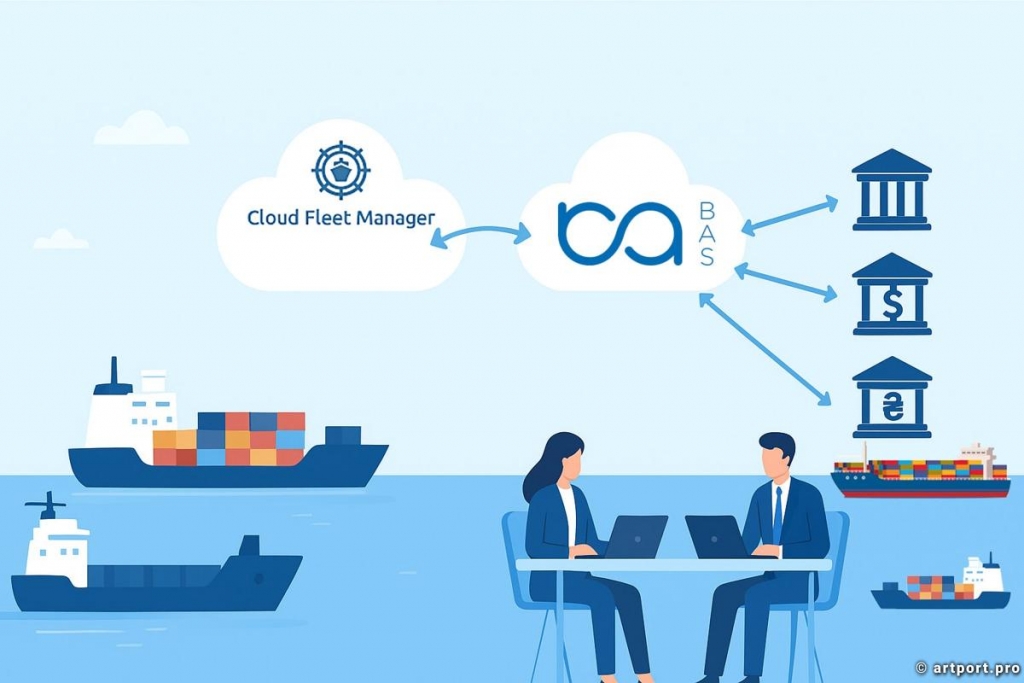
The shipping business today remains the backbone of the global economy: more than 80% of international trade is carried out by sea transport. For Ukraine and Europe, maritime transport has particular importance, as it ensures not only the export and import of key goods — grain, metals, energy resources, industrial equipment — but also the resilience of supply chains under conditions of geopolitical instability. Speed of data processing, operational transparency, and compliance with environmental and international standards all play a crucial role in this process. That is why shipping companies increasingly need digital tools that allow them to manage their fleets efficiently, safely, and profitably.
Traditional methods — Excel spreadsheets, paper document flow, and a variety of fragmented software solutions for local tasks — can no longer cope with the growing volumes of information and the requirements of international standards.
Automated Fleet Management System
This is where automated fleet management systems, designed specifically for shipping companies, charterers, and shipowners, come into play.
A Fleet Management System (FMS) consolidates all key processes into a single digital space: vessel management, voyage planning, crew management, procurement, technical maintenance, and financial accounting. Such a system is essential for large corporations with dozens of vessels as well as medium-sized companies seeking greater transparency, cost reduction, and easier collaboration with partners.
Among modern systems, cloud-based solutions stand out. Their main advantages are real-time access to data from anywhere in the world, a high level of automation, and integration with international and local accounting systems. For businesses, this means not only lower operational costs but also strategic advantages in the global market.
However, every company must maintain its own managerial and accounting records using specialized software. Ukrainian companies, as well as European ones with “Ukrainian roots,” typically use BAS-family software. This creates a need for automated data exchange between two different systems.
Let’s look at a real case of integrating managerial and accounting systems with the popular European fleet management system Cloud Fleet Manager (CFM).
What is Cloud Fleet Manager?
Cloud Fleet Manager (CFM) is a cloud system developed by the German company Hanseaticsoft (part of Lloyd’s Register), which combines in one space:
- vessel and voyage management,
- crew operations,
- procurement and supply,
- technical maintenance,
- primary data for financial accounting and reporting.
Main functions of CFM:
CFM consists of several modules that can be connected as needed:
- Fleet Manager – stores data for each vessel (characteristics, certificates, repairs, status).
- Crew Manager – crew management: contracts, schedules, medical examinations, certification.
- Maintenance Manager – planned and unplanned technical maintenance, repair control.
- Purchase Manager – procurement, vessel supply, warehouse control.
- Safety Manager – compliance with ISM/ISPS requirements, checklists, incident reports.
- Charter & Voyage – voyage and charter management, calculation of expenses and income.
- Partner Portal – separate access for clients and partners (they can view schedules, voyage status, reports).
- Reporting & Analytics – ready-made reports and dashboards for management.
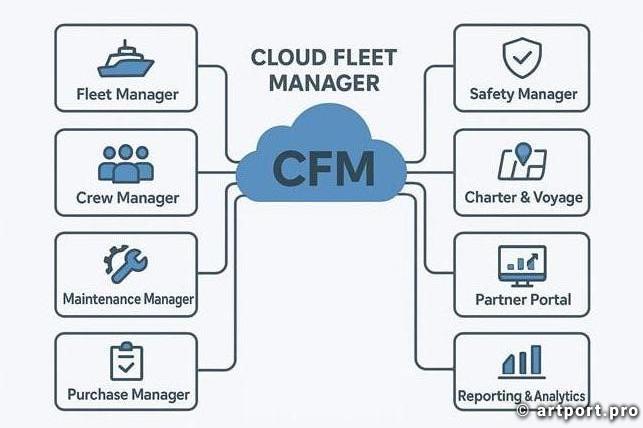
What are the benefits of using this system:
- Centralization – everything is in one system, no fragmented files and databases.
- Access from anywhere – works in a browser or application, requires only internet access.
- Transparency – shore-based staff, crew, and partners see up-to-date data.
- Automation – less manual work, faster information exchange.
- Compliance with international standards – helps to comply with IMO, ISM, ISPS, MLC requirements.
- Flexibility – you can connect only the necessary modules (for example, only Crew + Maintenance).
Integration with Financial (Accounting and Management) Systems of the BAS Family
CFM does not provide accounting, management accounting, or budgeting capabilities. Therefore, it is important to be able to integrate CFM with the company’s financial accounting system.
This requires:
- Integration of directories, in particular – contractors, companies in the holding structure, goods and services, currencies, units of measure, etc.
- Integration of invoices and orders, for example, for fuel and spare parts.
- Movement of funds, in particular, the accrual and payment of salaries.
When implementing the integration, three options can be distinguished: minimal (data is collected in real time, and invoices are checked in the accounting department), with the transfer of orders and checking of invoices in the accounting system, or with full synchronization and control in CFM.
For the correct operation of CFM and the accounting (management) system, it is first necessary to set up the integration of contractors, otherwise manual maintenance of lists in both systems can cause errors. Initially, it is determined which system will be the «master». Records about contractors and the main identifier—usually the «contractor ID»—are created and updated in it. In the future, all data is synchronized through an API. If the master system is CFM, the accounting department periodically receives updates from there; if it is the accounting department, it sends changes to CFM itself.
CFM supports API integration, which allows:
- transmitting financial data for voyages to BAS (income, expenses, port charges, fuel);
- loading procurement and supply data (applications from CFM are transformed into orders and invoices in BAS products);
- synchronizing crew data (contracts, salaries, taxes);
- accounting for repairs and maintenance (costs and materials are transferred to accounting).
- And much more.
In Ukraine, BAS products are the most popular accounting solutions. European equivalents offer additional features such as:
- Multilingual interface – the systems are available in different languages, which facilitates their use in international operations. Moreover, each workstation and each employee can simultaneously work with the interface in the language convenient for them.
- Built-in modules for international trade: multi-currency accounting, management of branches in different jurisdictions, warehouses, and divisions.
In one of its projects implemented in 2025, the company «Art Port» developed a solution for the software integration of CFM and the BAS product family.
The client company of the project was already actively using «Cloud Fleet Manager» to manage vessels, crews, and supplies, but faced the need to link it to financial accounting according to international and local standards.
The project implementation required the development of an integration between the two systems that had to:
- automate data exchange between CFM and BAS;
- ensure transparency in the calculation of voyage expenses and revenues;
- simplify the preparation of financial and tax reporting.
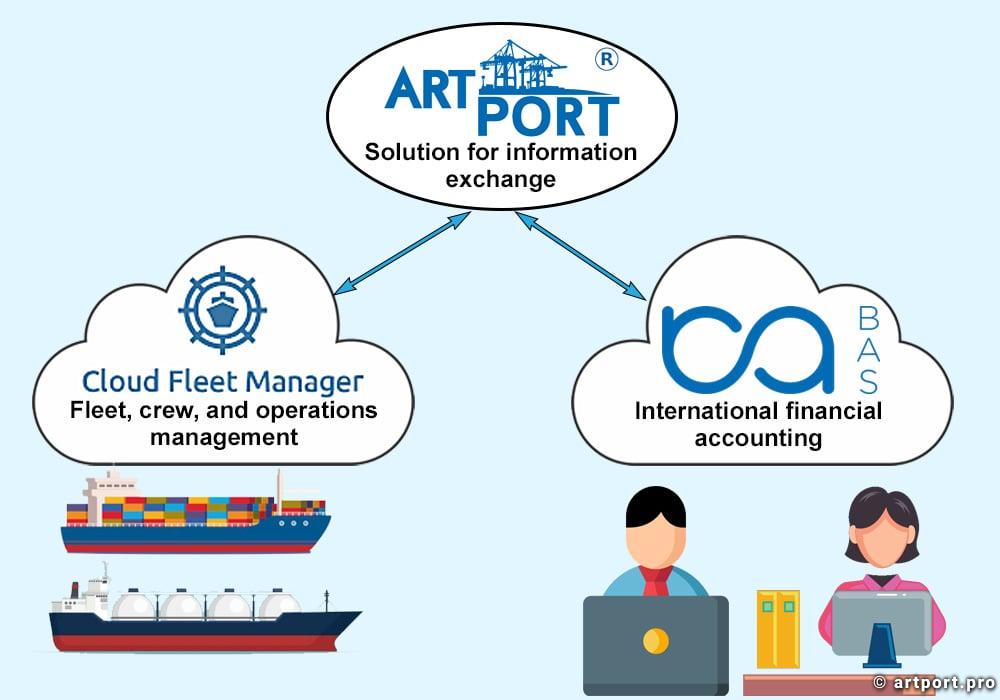
The exchange with CFM in BAS can look like a single button. But, under this button, all the huge work done to enable information exchange between the two systems is «hidden».
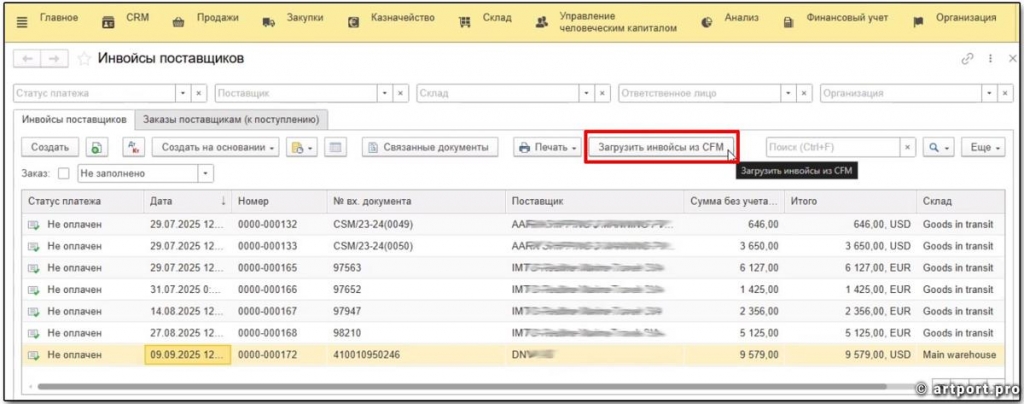
Loading invoices from CFM into BAS
Let’s consider, for example, several integration scenarios for CFM with BAS.
- Voyage and charter management:
- In CFM: the dispatcher plans the voyage, the system records fuel consumption, port fees, and charter income.
- Exchange with BAS: data is automatically uploaded in the form of financial documents (income/expenses for the voyage).
- In BAS: the financial result for the voyage is formed, and a report for accounting and management is prepared.
- Procurement and supply:
- In CFM: the crew or office submits applications for vessel supply (food, spare parts, equipment).
- Exchange with BAS: the application is converted into a «Supplier Order».
- In BAS: warehouse accounting is maintained, invoices are issued, balances are automatically updated, and all related operations are performed and reports are generated.
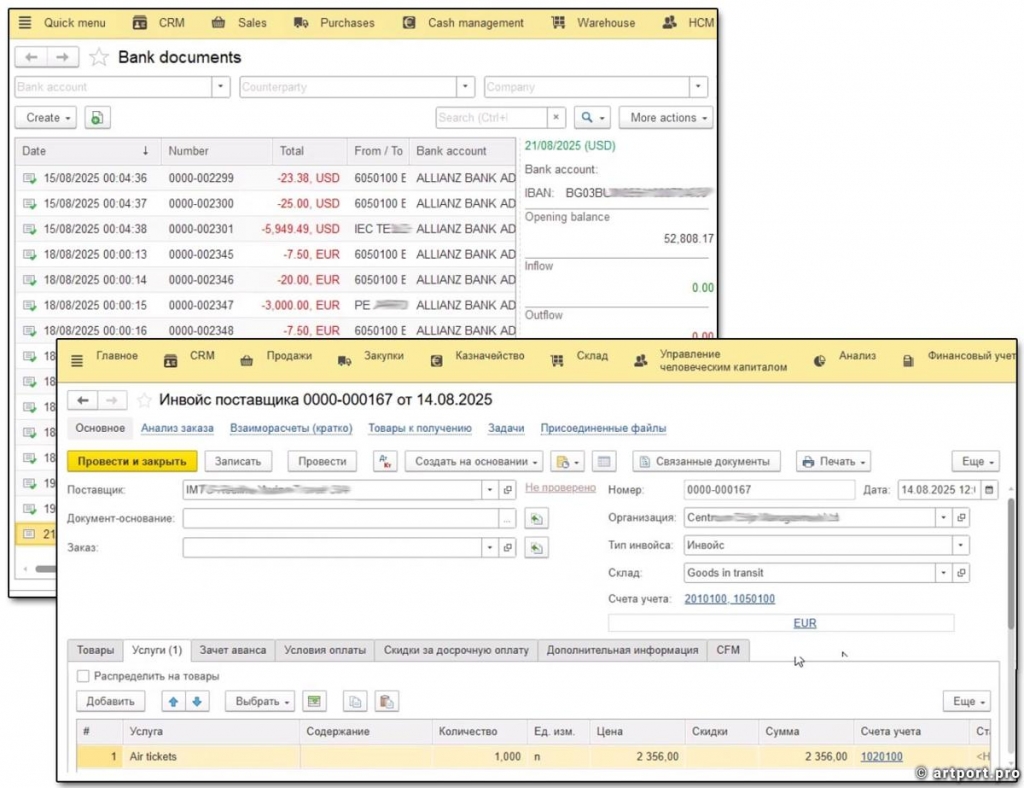
Bank documents and supplier invoices
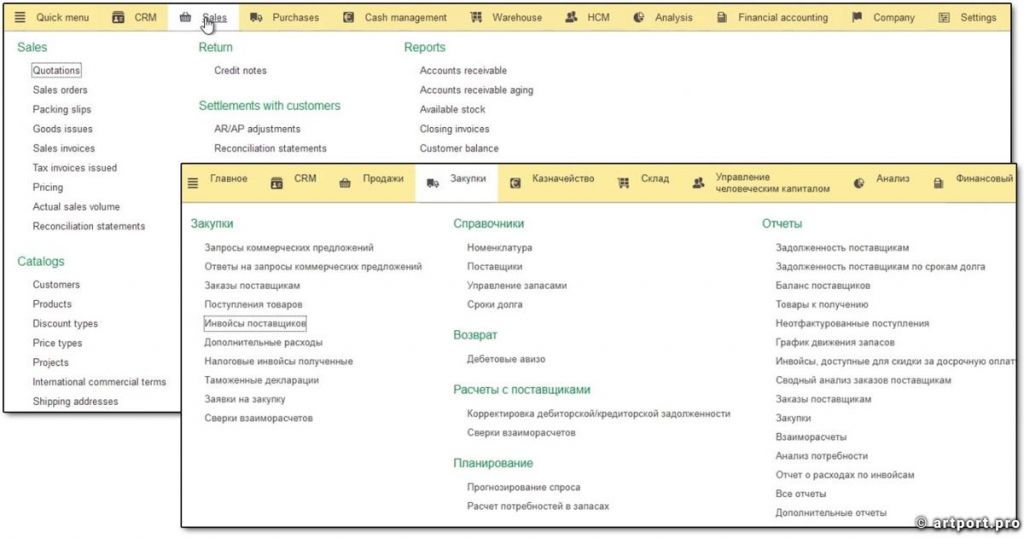
Purchases and sales in the accounting system in selected languages
- Crew management:
- In CFM: crew contracts, rotation schedules, and salaries are saved.
- Exchange with BAS: data on salaries and taxes are exported for salary calculation and reporting.
- In BAS: salaries and taxes are calculated, information is exchanged with Ukrainian or European banks (statements, payments, etc.), and reports for regulatory bodies are generated.
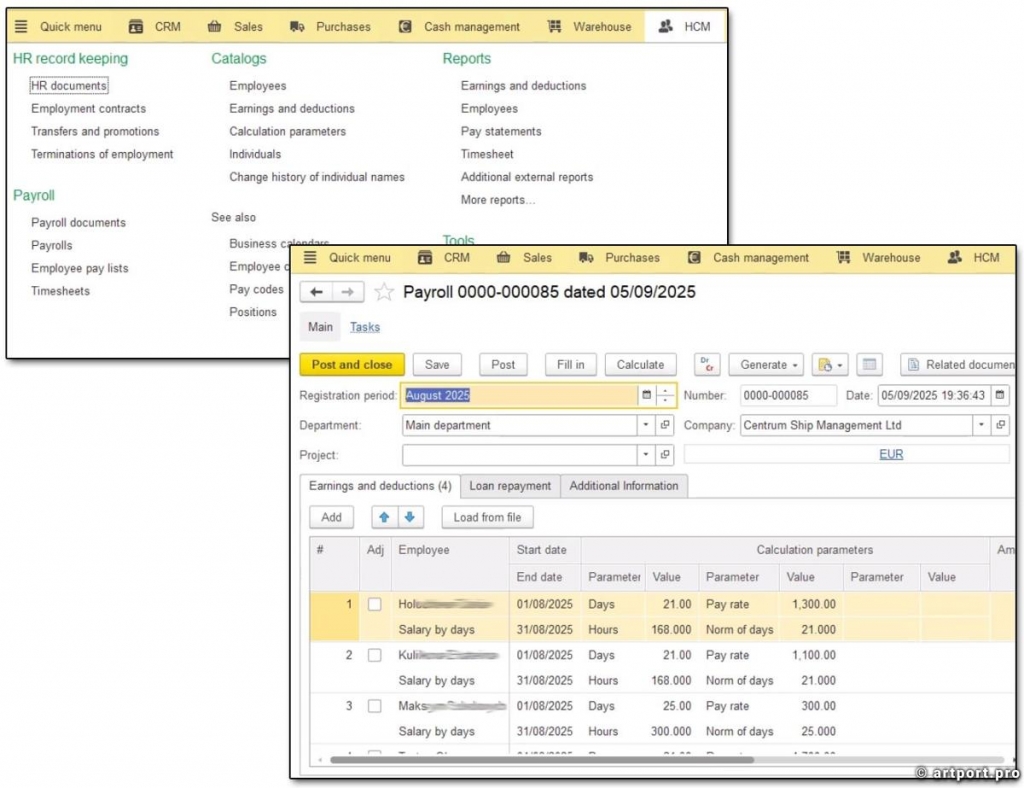
Accrual of salaries to the crew
- Technical maintenance and repairs:
- In CFM: the system records planned and emergency repairs, and maintenance costs.
- Exchange with BAS: expenses are uploaded to BAS products.
- In BAS: distribution to accounting (management) accounts and write-off of materials are performed, acts are formed, repair or maintenance costs are closed, and assets are accounted for.
- Financial analytics and reporting:
- In CFM: you can build analytics for voyages, fleet, and supply.
- In BAS: this data is supplemented with local reporting (VAT, profit tax, balance sheet, etc.).
- Result: management receives a single financial window – international analytics (CFM) + local reporting in BAS products.
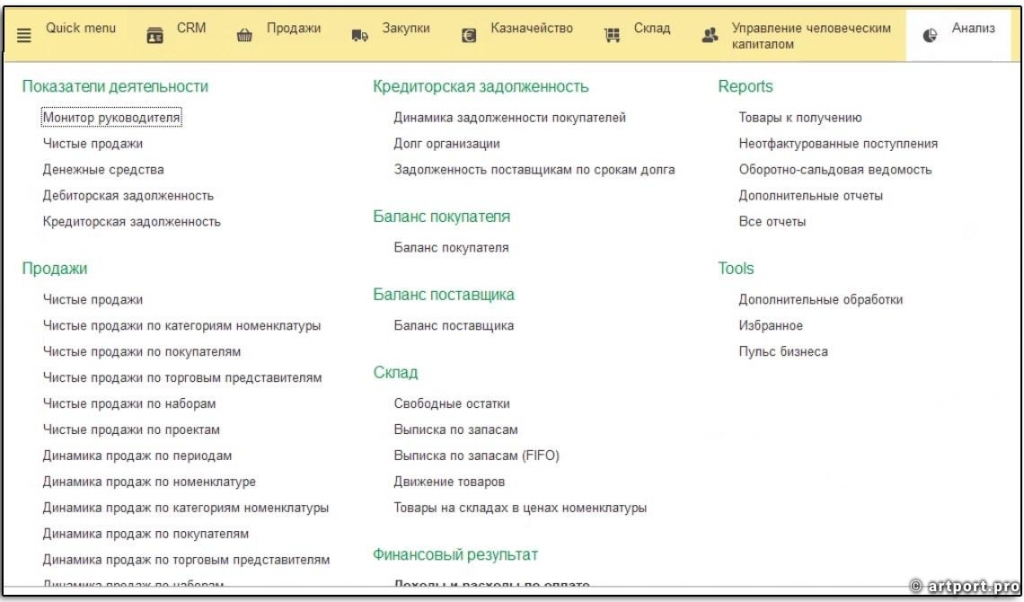
Analysis and reports
Benefits of such integration
- Single information flow – data is entered once and automatically goes to both CFM and BAS products.
- Accounting automation – voyage expenses and income are immediately reflected in the accounting.
- Error reduction – minimization of manual entry and duplication of documents.
- International standards + local reporting – CFM gives analytics for the fleet, while BAS products generate reports for regulatory and tax authorities.
- Increased transparency for management – a single window with international and local indicators.
Who benefits from this?
In Europe — medium and large shipping companies (5–200 vessels) working with international clients and partners. The integration of CFM with local ERP provides full compliance with market and regulatory requirements.
In Ukraine — shipping, freight forwarding, and logistics companies working according to Ukrainian accounting rules and required to submit reports to local regulatory bodies. The integration of CFM with BAS allows such companies to work according to global standards and simultaneously comply with Ukrainian accounting rules.
What can be said in conclusion
After the implementation of this project, the client company received the following benefits:
- A single system was created from the order in CFM to accounting and reporting in BAS.
- Reduction of manual labor, elimination of errors and the «human factor».
- Full synchronization of operations and data in CFM and BAS.
- Acceleration of calculations and preparation of reports according to international (IFRS) and local rules.
- Automation of interaction with banks.
- Readiness for scaling.
- Transparency for management – a single window with data on the fleet and finances.
The solution developed by «Art Port» allows:
- Ensuring information exchange between CFM and accounting and management accounting in BAS.
- Controlling the movement and control of funds allocated to each expense item for a voyage.
- Exchanging information with Ukrainian and foreign banks.
Cloud Fleet Manager is not just a fleet management tool but a full-fledged digital ecosystem for the shipping business. Integration with BAS products turns CFM into a universal solution: international standards + local reporting.
And this is not just a technical solution. It is a strategic step towards a company’s digital maturity, compliance with international requirements, and increased competitiveness.
The solution from «Art Port» turns complex processes into transparent data flows — from voyage to balance sheet, from invoice to report.







